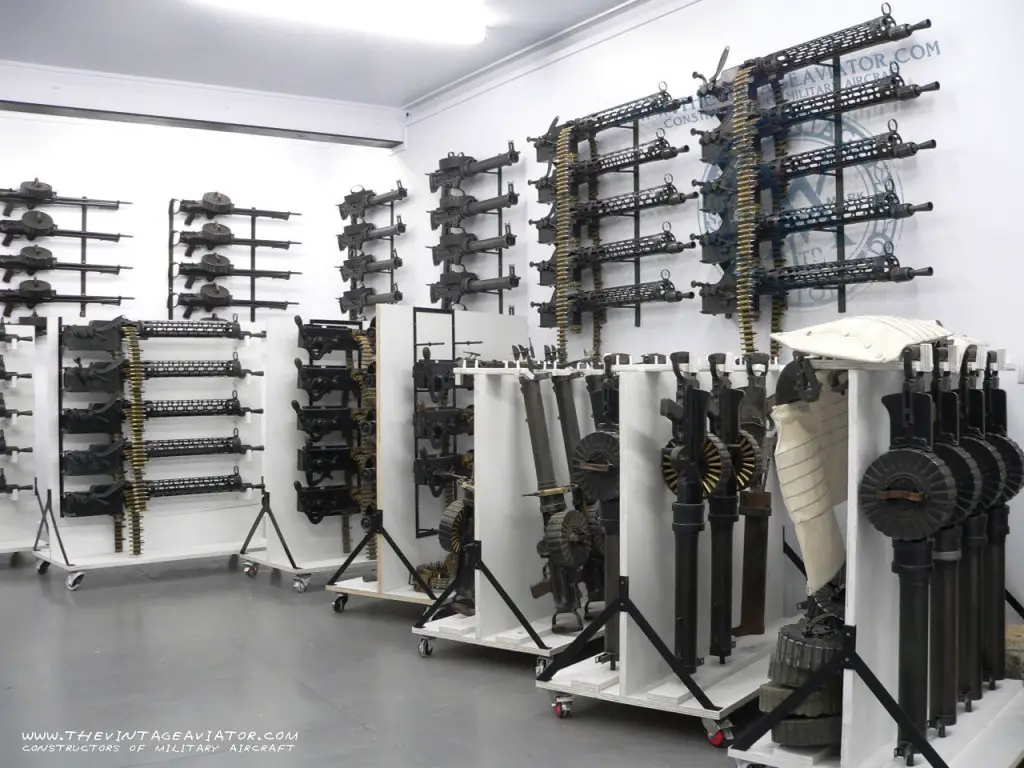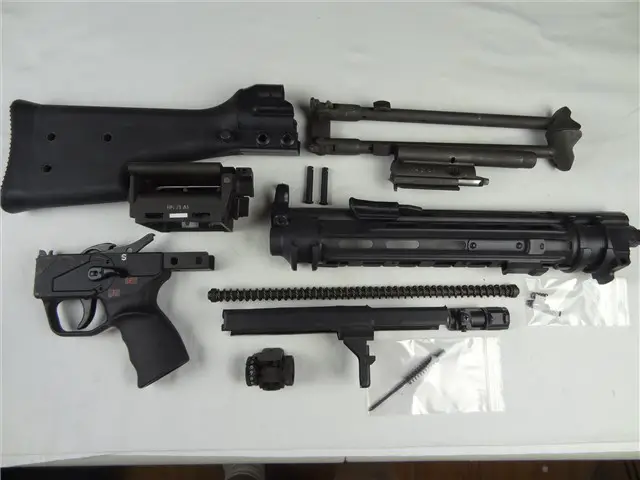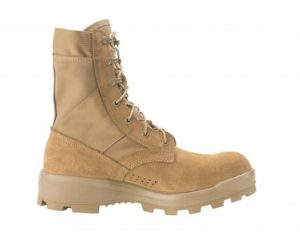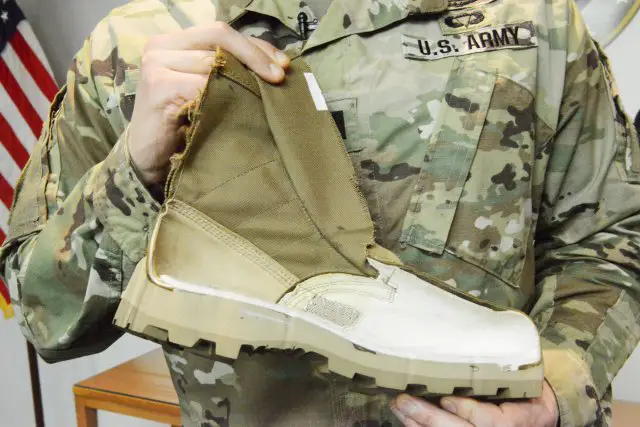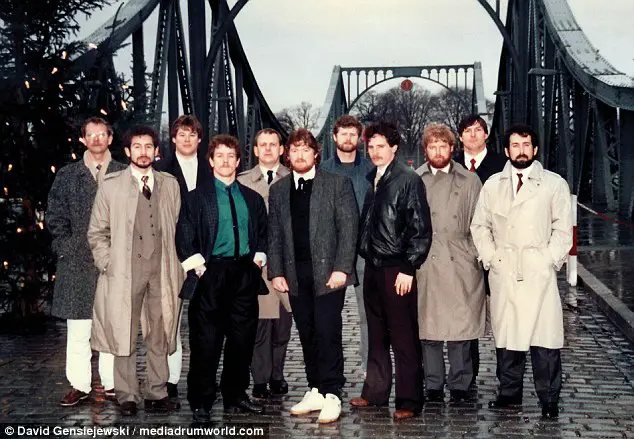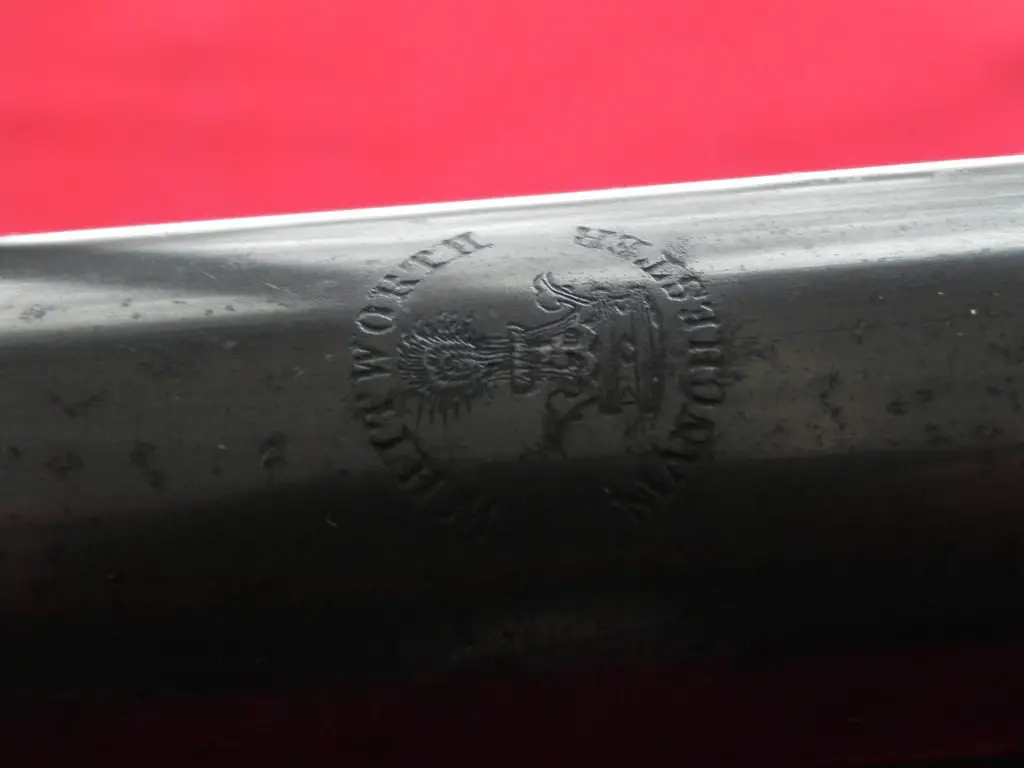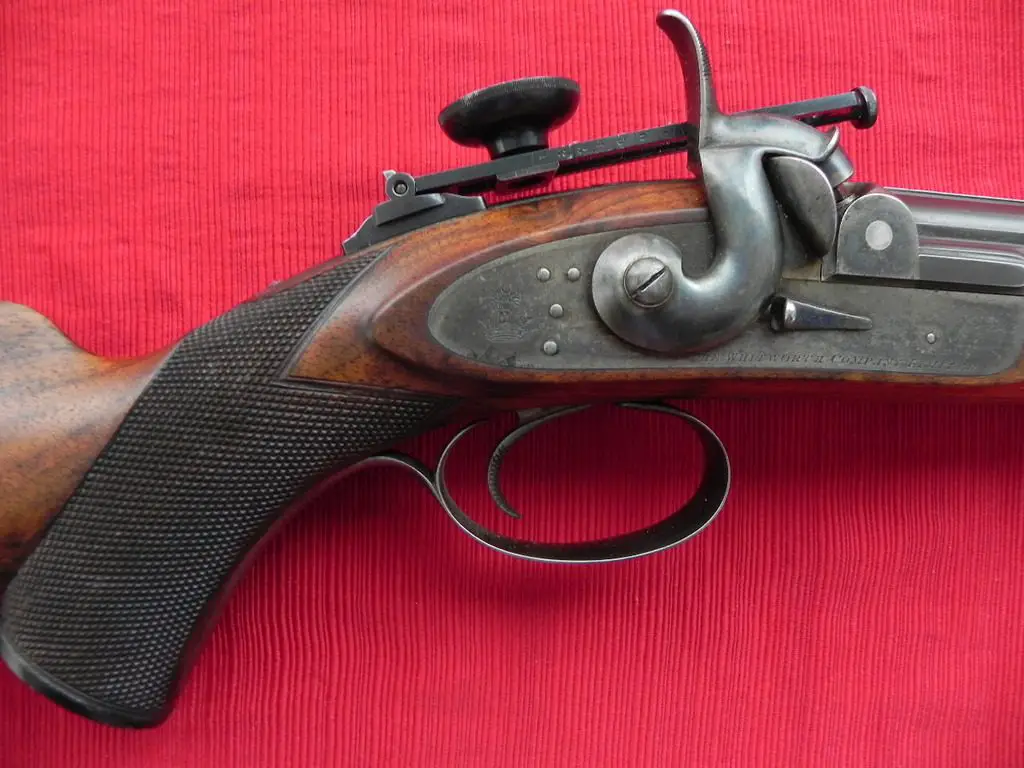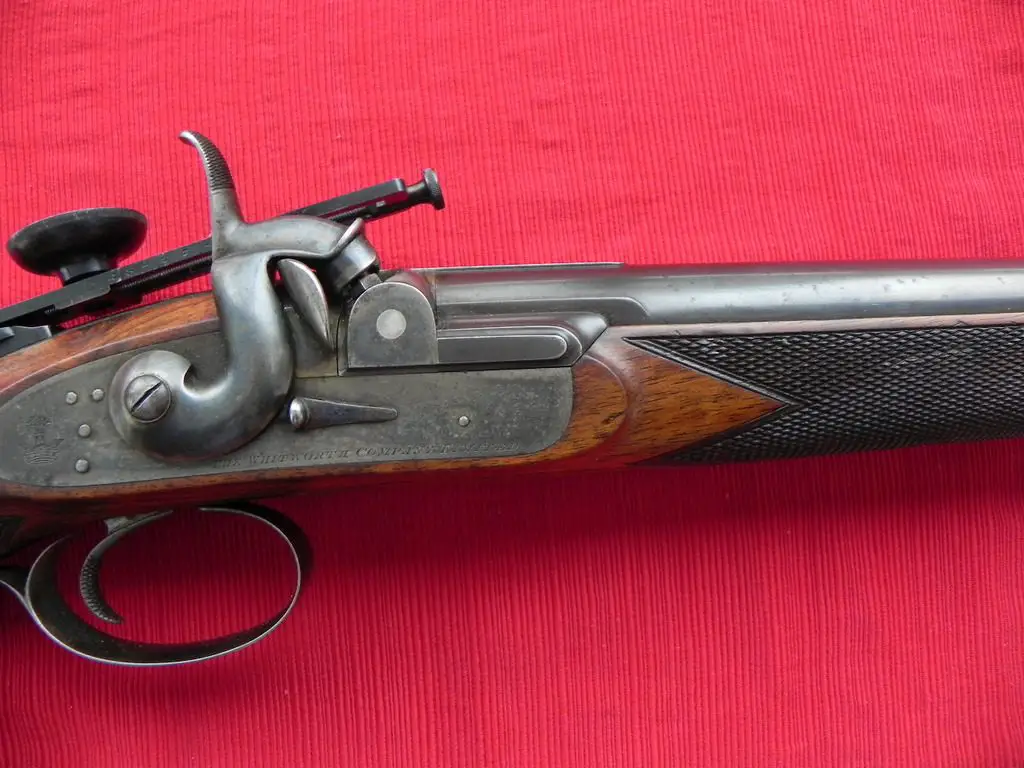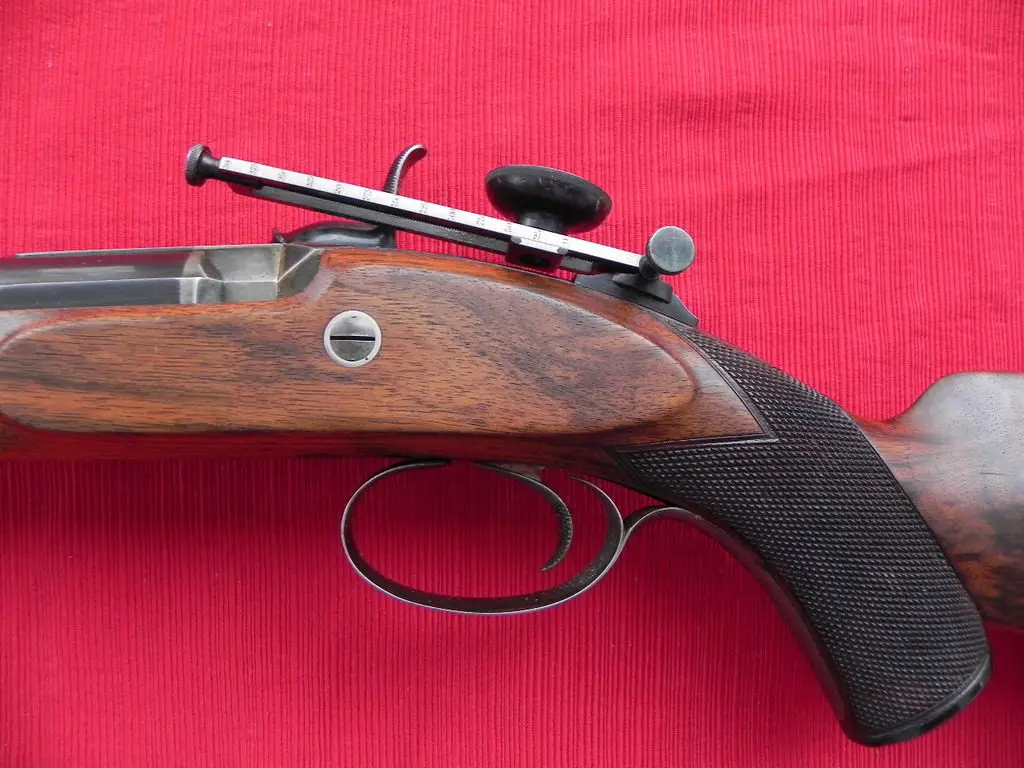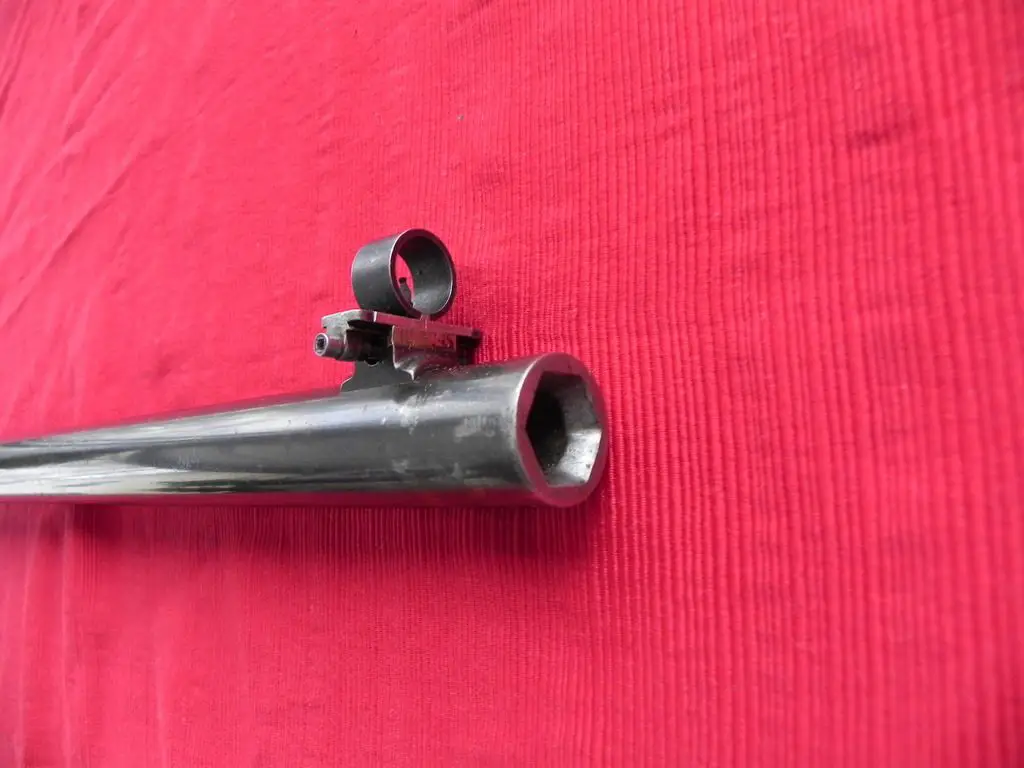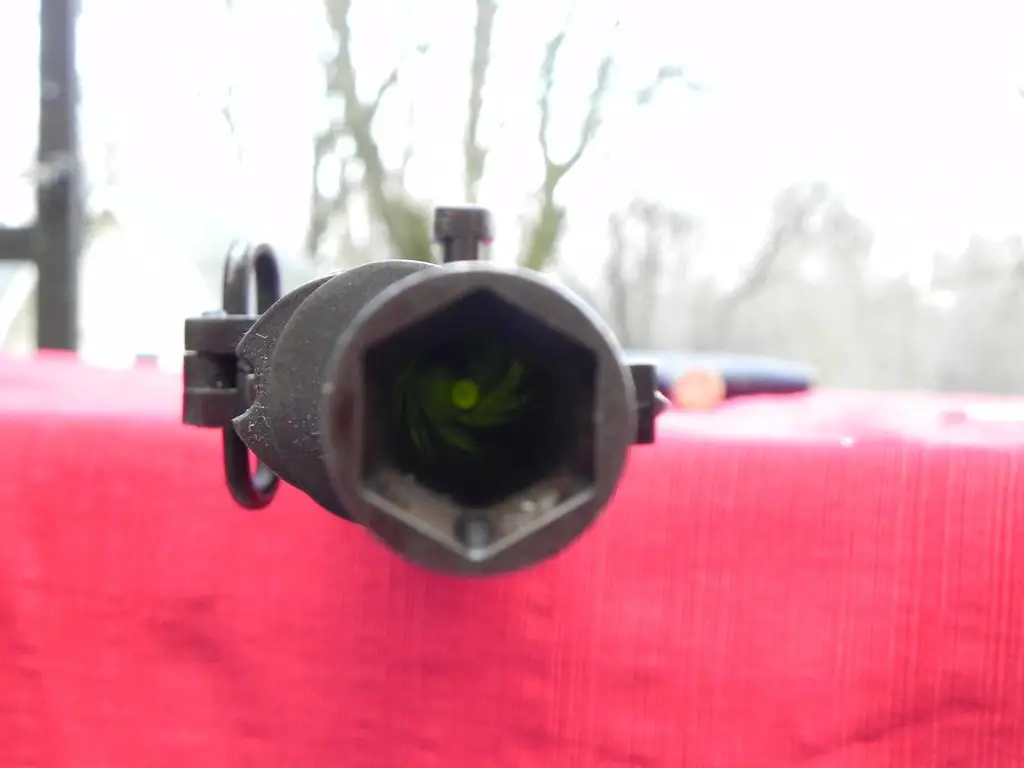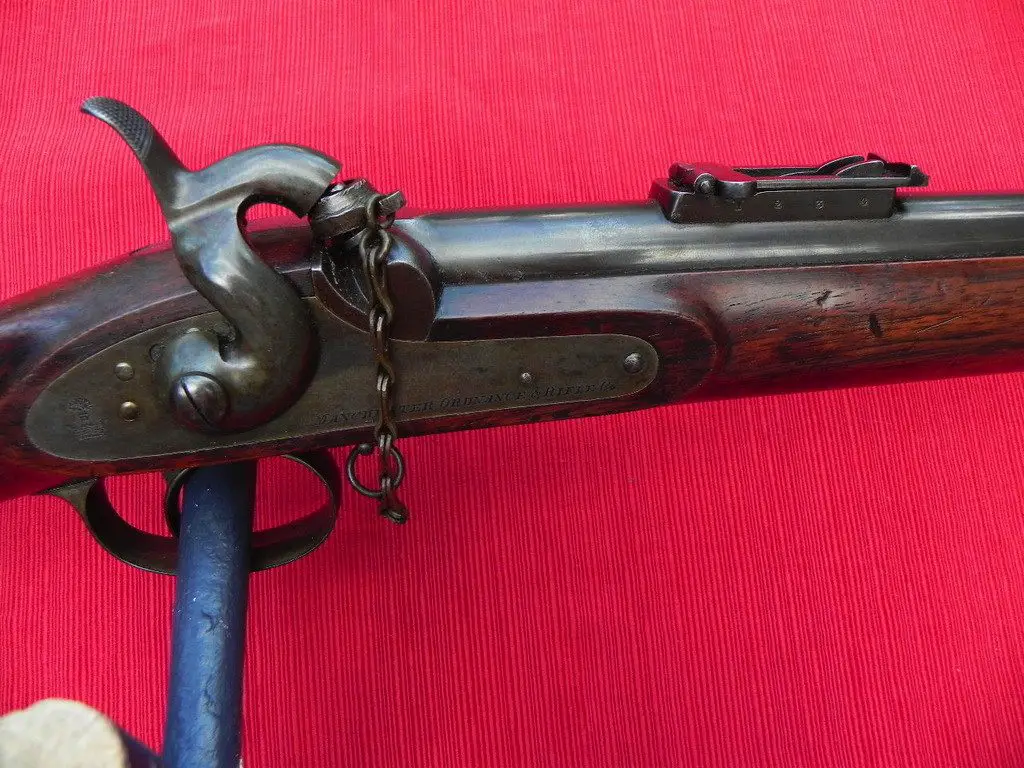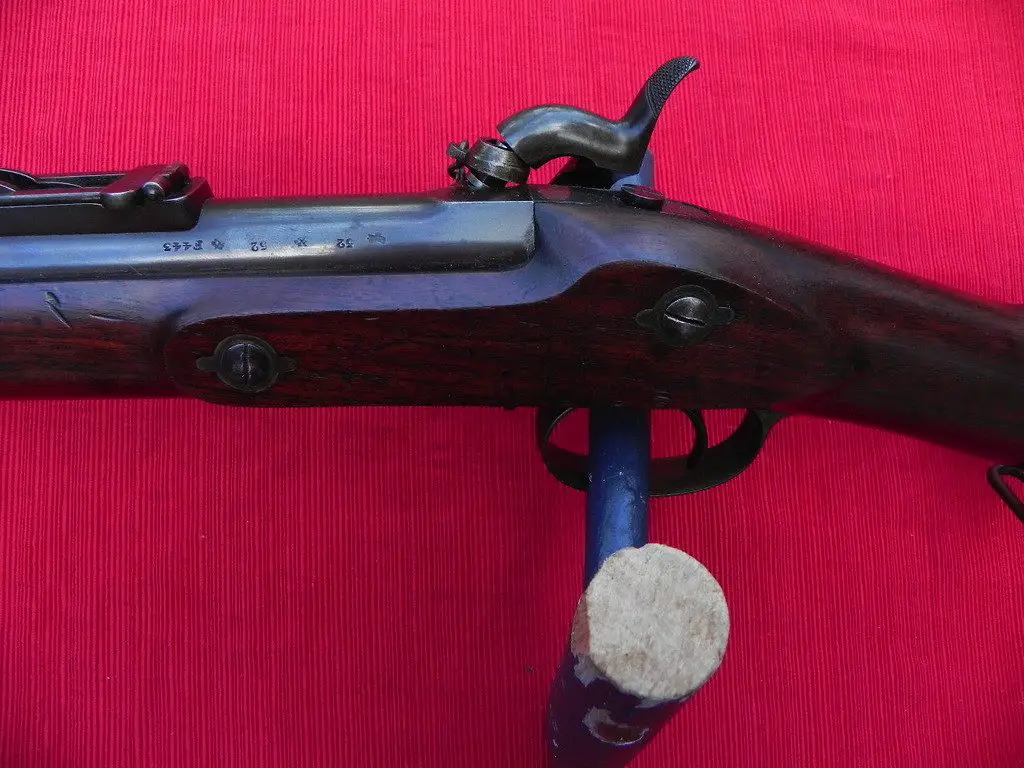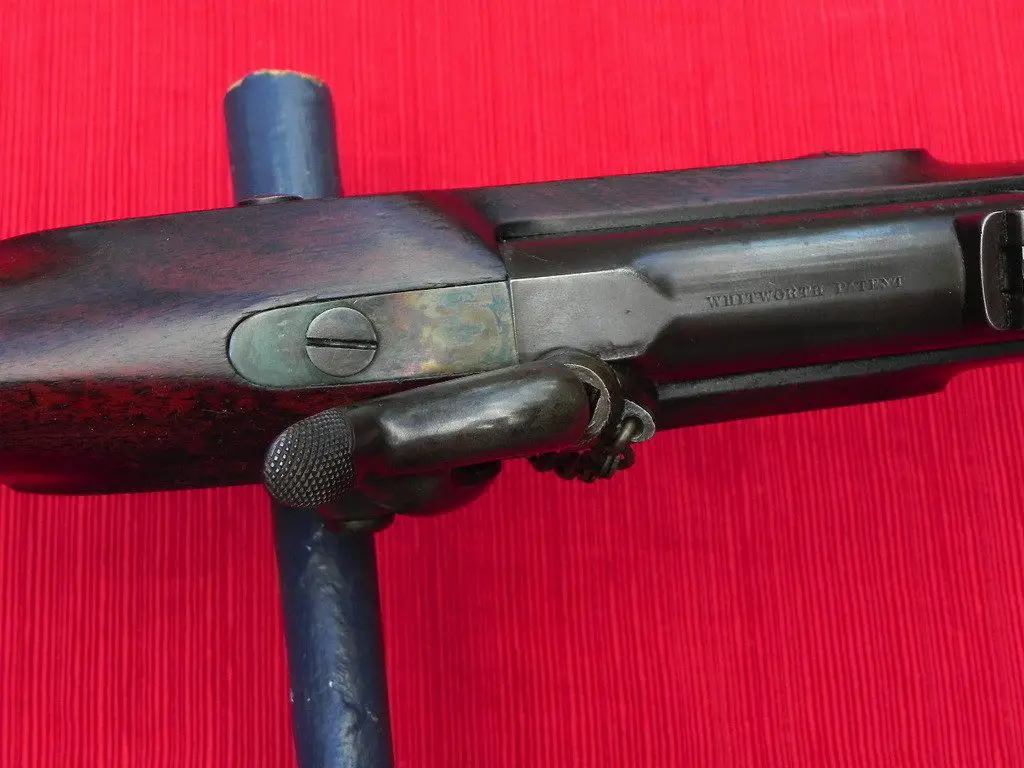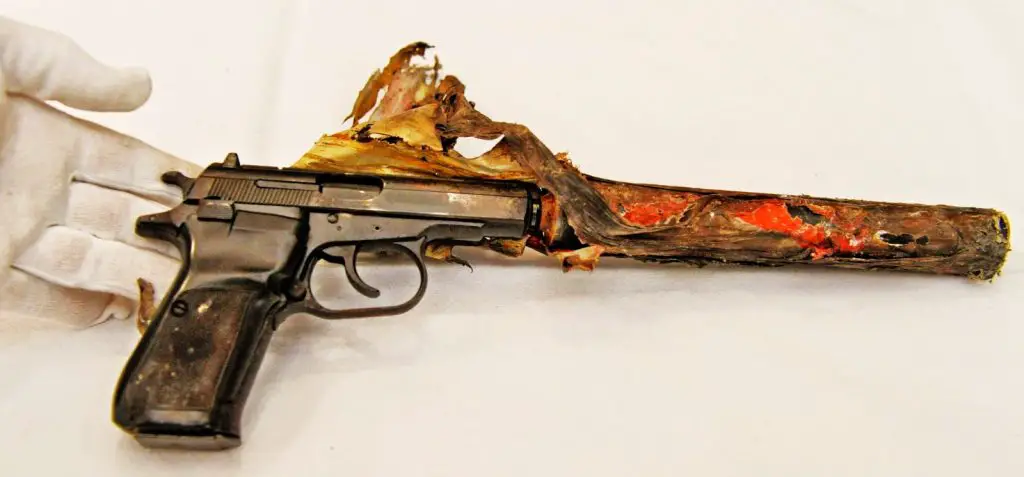Category Archives: Uncategorized
 Is it just us, or does the Republic of South Africa produce more than its fair share of weird homicides?
Is it just us, or does the Republic of South Africa produce more than its fair share of weird homicides?
In this case, a youth from a wealthy family killed ’em all, or tried (a kid sister survived), and then called the cops with a transparent story that Sumdood did it.
Henri Van Breda, who handed himself over the police in September last year, is accused of murdering his father Martin, 54, a wealthy businessman, his mother Teresa, 55, and older brother Rudi, 22, in a frenzied early morning axe attack in the heart of South Africa’s western Cape vineyard area.
His younger sister Marli, who was 16 at the time of the attack, was left for dead on a balcony. She survived, despite a cut to her jugular vein and severe head injuries.
Van Breda appeared calm and smiled briefly as he appeared in the packed court room wearing a blue suite.
The case was postponed to April 24 because the defense said it had not received crucial DNA reports about the murder weapon from the state.
Van Breda, who is out on bail, has agreed not to contact witnesses, including his sister. He is also forbidden from being within 500 meters (yards) of an airport or a harbor.
Kind of amazing that a guy charged in a crime like this is bailed.
According to police, when officers arrived at the crime scene they found Van Breda sitting outside the house, wearing sleeping shorts and white socks stained with the blood of the victims. He was taken in for questioning and later brought back to the house, where investigators found a bloodstained axe and kitchen knife. He was later released into the care of an uncle.
Marli van Breda, who has been living with other members of the extended family, is suffering amnesia and unable to recall the incident.
That’s a relatively common occurrence, after being brained with an axe, actually.
On the morning of the attack van Breda had phoned his girlfriend at 4 a.m. but only called paramedics three hours later.
A recording of van Breda phoning the emergency services emerged in which he can be heard telling the operator: “My family and me were attacked by a guy with an axe.”
via South African man, 22, in court for axe murder of his family – NY Daily News.
This certainly looks like one of those Richard Pryor jokes come to life:
“Why did you kill your whole family?”
(Pause, thinking). “They was home.”
You know, it’s sad when a mentally ill person kills himself, but it might not be the worst thing.
A Czech Gun You’ve Probably Never Seen….
…well, unless you’re Czech. Or Canadian. It’s the CZ 122 Sport.
It’s marked with the logo of CZ-UB and appears to owe nothing to the CZ-75. It’s just an attractive, modern .22 target pistol. (Look how low the bore axis is!)
A few of these were imported about ten years ago… to Canada. None to the Great Red White and Blue South. So they have more to gloat about than the bulk of the world’s greatest hockey players.
And no, we don’t know why they weren’t brought here. Maybe they think they can’t be price-competitive with Rugers, Brownings and other mass-produced .22 plinkers?
We think we’d want one even if it wasn’t a CZ, because it’s cool looking. Maybe there are some echoes of the Kratochvil brothers’ vz. 50 service pistol and vz. 52 army pistol designs in it? It’s got just a little “space gat” vibe to it.
We found it here, and there’s a Reddit thread where the guy who posted the picture said this about it:
CZ 122 sport edition. Chambered for .22LR. Not too much other information on this specific gun. Shoots like a dream and is pretty space-ey.
From my understand they are mega rare. No idea on production run. They are 875 grams, hold 10 rounds and are 24 cm long. Buddy found it here in Ottawa and has seen one other out in Calgary. According to some people of gun blogs from 2005 they didn’t import them into the states.
Wonder what it’s story is. We’ll have to dig into the latest Czech language sources and see.
Which brings us to a poll…
As ever, we value your opinions. And we reserve the right to act on them, or not!
OT: Animal Behavior and Highway Driving
 Humans are not animals, at least not in our value system. But in terms of mechanisms both physical and behavioral, there’s certainly some commonalities. Behavioral scientists, whose field has picked up in respect what it’s lost in pizzazz since the days of B.F. Skinner, insist that many (some say all) human behaviors can be explained by reference to our animal, evolutionary past.
Humans are not animals, at least not in our value system. But in terms of mechanisms both physical and behavioral, there’s certainly some commonalities. Behavioral scientists, whose field has picked up in respect what it’s lost in pizzazz since the days of B.F. Skinner, insist that many (some say all) human behaviors can be explained by reference to our animal, evolutionary past.
Jack Baruth, an automotive writer who specializes in stoking controversies, says that bozo driver behavior is actually explained by animal instincts that survive in the atavistic core of Homo sapiens. First, he reminds us all how little we like….
…the people who wander from lane to lane for no reason. The drivers who speed up to match you as you pass them on the freeway, not out of anger or machismo but simply because their subconscious herd-animal instincts tell them that it’s completely safe and comforting to be driving at 75mph next to another 4,000-pound unguided missile. Tailgaters. People who can’t merge at speed. I could go on, but I think you get the idea.
Yeah. Hell is other people, on the highway. And they usually have Massachusetts plates, but that’s a whole other rant. So where does the animal bit come in?
I’ve watched drivers unconsciously pace me all the way from 55mph to 85mph or more as long as I increase my speed one MPH at a time, or from 85mph to 55mph if I slow down by the same increment. They’re not trying to be annoying; they are just operating on the herd principle buried in their backbrains. But if I slam on the throttle and go from 60mph to 70mph at max acceleration, they won’t follow.
If you move over for a faster car that then slows down right ahead of you, try moving back in behind them. They will almost always slow down 5mph or so, because they are slightly nervous at seeing you appear in their mirror. Then you can return to your previous lane and pass them again, using sharp acceleration to put distance between you and them and break the herd behavior.
He has several suggestions for, actually, manipulating the unconscious, herd-brain instincts of the inattentive driver.
…All of these tactics, and many more that you’ll discover independently, have one thing in common. They are designed to break the herding instinct by making you more visible, or more worrisome, to the unconscious driver. They turn you from just a comforting, indistinct presence in their mirrors or windshield to an actual, noticeable automobile that might not be worth sticking so closely to.
Naturally, we’re going to tell you to Read The Whole Thing™. Sometimes we find Baruth and his towering ego, which is so centrally present in each column as to deserve co-writer credit, annoying. But in this column he named several things that we do to keep moving on the road, and it never occurred to us to use the template of herd-animal behavior as a way to understand the migrating Massholes driving three abreast at three miles under the speed limit, with twenty miles of cars backed up behind them.
We’ll never think of them the same way again. But we’ll probably continue cursing them. That’s our instinctive animal behavior.
Shop Soulcraft
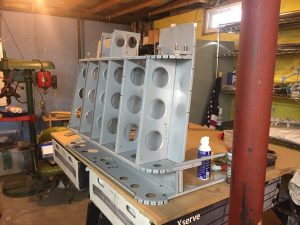 Bear with us as we talk about two disparate things — screwing up and hand tools. They both go tool in hand, er, hand in hand. And it all started in the workshop today.
Bear with us as we talk about two disparate things — screwing up and hand tools. They both go tool in hand, er, hand in hand. And it all started in the workshop today.
We have the center section of the airplane starting to come together on a temporary table (horses and MDF) down in the gunsmiting lab. (Yes, before anyone asks: when it’s complete, it will fit out at least one of the three exits. We measured).
Ah, “measured.” What a fine and noble word that is. And what grief befalls the workman who neglects to do just that. And thereby hangs a tale. (Does a tale hang by its tail? Only its tailor knows for sure).
Over the last few nights we prepared to install the baggage compartment floors, structural parts that are fastened to a built-up section of the main spar carry-through by approximately three dozen solid rivets. After a scan of the plans, most of the rivets were emplaced as AN470AD4-8s, and four outboard rivets that went through an additional .040″ or so were emplaced as AD4-9s. These rivets are identical rivets except for the length.
There is a code to AN rivets, which is inscrutable to the uninitiated but becomes second nature after the 3,712th one you’ve driven (or maybe it’s the 882nd one you’ve drilled out because you drove it wrong). These two sizes break out as follows:
| Item | AN | 470 | AD | 4 | 8 |
| Meaning | Army-Navy standard | Standard round head rivet | shank dia. 4/32″ | shank length 8/16″ | |
| Item | AN | 470 | AD | 4 | 9 |
| Meaning | Army-Navy standard | Standard round head rivet | shank dia. 4/32″ | shank length 9/16″ | |
Before our European and Antipodean friends begin grumbling about the superiority of the French Revolution’s system of weights and measures (if they were going to keep something of Robespierre’s, why not the guillotine? But we digress).
The rivets were difficult to drive because the sheet metal floorboards themselves limited tool access. We drove them using teamwork and great care, worried about putting a “smile” on a rivet head and having to drill a rivet out.
Today, as we contemplated a neatly driven row of AN rivets, the Blogbrother revisited the plans page and came up with an unwelcome insight:
“Hey, I think we put in the wrong rivets.”
“Nonsense. Dash-8s, and 9s for the two outboard rivets on each side where they go through the upright, too.”
“That’s not what the plans say. Dash-9s and 10s.”
“Uh. Intercourse.”
So now we didn’t have to drill out one mashed “smiley.” Nope, we had to drill out all 36 or so rivets. Every single one is 1/16″ too short. And the part they’re embedded in is a structural part: there’s no margin for error.
We set to drilling. Which brings us to hand tools.
Our grandfather often drilled a hole with a traditional hand drill, a bit and brace, or a small thing we called a “hand drill” but have since learned is actually properly named a “pin vise.” Today, most workshops don’t have any drill but an electric drill, and usually it’s an enormous cordless monstrosity with a gigantic battery hanging off it.
Now, it’s possible to drill these rivets out with a power drill and a long (12″) bit. But this is where the voice of Gamuck speaks to us and sends us to the hand tools. For $50 you can get a collection of pin vises in various sizes, and they have a bunch of uses. (For instance, that #60 drill that the chuck of Monster Drill won’t hold? Chuck it in a small pin vise, and then chuck the pin vise in Monster Drill. If all the chucks are concentric — not always guaranteed if you buy cheap, or even if you don’t, we’ve seen Starrett pin vises that were nonconcentric or out of round — it’ll work just fine).
You should have one or two big pin vises and a set of small ones. (If you like to keep a lot of bits handy, you can use double-ended small ones, but label the GD bits). What we’ve got in the shop is just that: a large heavy pin vise (about the size of a screwdriver handle) made by General Tool, the generic name for Chinese stuff in Ace Hardware or Harbor Fright); one about the same size but very light due to a hollow handle (for storing common bits), from the Israeli firm Shaviv, one small one with a cap with a bearing, made in India, and a set of generic small pin vises with solid handles, also made in India (these are the ones ideal for chucking into the Drill Monster).
Along with these, you’d be surprised with how much metalwork you can do with a set of files and one of stones, and a hacksaw and assortment of blades. With hand tools you can feel the metal directly. Yes, you lose speed compared to power tools. But what you gain is control.
Consider our problem, a row of rivets that had to be drilled out because the shanks were all 1/16″ too short before being squeezed, but where a power drill with normal jobber-length bits would not have access. There were three ways to do this that came immediately to mind:
| Name | Pro | Con | |
| 1: Power Tool Solution | Drill Monster with 12″aviation-length bit | Fastest solution | High probability of enlarging or misshaping hole |
| 2: Hand Tool Solution | Drill bit in pin vise | Great control at all times, low probability of overdoing it | Slow as molasses |
| 3: Hybrid solution | Mark, hand drill to start hole, finish with power drill | Best balance of rapid completion and no damage | Slow, fiddly, lots of “paradigm shifts” for guys doing it. |
Needless to say, we went with option #3. AN rivets have a tiny dimple at the center of the head, just to assist if you should have to drill the rivet out. We expanded this dimple with a center punch (another must-have tool, and one you can safely buy cheap). Five or six hits with the spring-loaded center punch made the dimple an even more prominent divot. Then, turning a #35 bit in the large, heavy pin vise, taking great care to make a good, centered cut, we cut enough of a hole in the rivet head that a carefully used aviation-length (12″) #35 drill bit in the Drill Monster would weaken the rivet enough for removal.
It’s going exactly according to plan. No parts damage, and so far all the rivets we’ve addressed are drilled through and removed, and we should finish the removal tomorrow.
And of the fact we once rived two skins on wrong, no more evidence will exist soon, except for this moldering blog post.
But no matter what you’re building, check out a variety of pin vises. They’re simple, cheap tools that are lifesavers when the hole is important enough that you want to feel it being cut.
Public Service Announcement: Lock it Up
 We’re working on a long story on an epidemic of organized-crime gun theft. It’s amazing just how many thefts are happening, and how many of them are being done by professional criminals. ATF has scores (no exaggeration) of open store burglaries, some of them smash-and-grabs by very fast-moving teams.
We’re working on a long story on an epidemic of organized-crime gun theft. It’s amazing just how many thefts are happening, and how many of them are being done by professional criminals. ATF has scores (no exaggeration) of open store burglaries, some of them smash-and-grabs by very fast-moving teams.
Their typical targets are pistols, first, and then black rifles, but any firearm hits every thief’s two-prong test: portable, and salable. These guns go on to circulate, most of them in the criminal, underground economy, and often turn up in crimes.
In addition to the store burglaries, which give organized crime (think MS-13 and the Hell’s Angels, not La Cosa Nostra) a revenue and weapons stream, there are lots of home burglaries. The haul for a home burglar is usually less (a gun or three) and often comprises only sporting or heirloom guns that have limited criminal utility. They still would rather steal them than many other products, even if they can’t use them in their crimes. While store burglaries give organized crime lots of late-model guns, residential burglaries probably put more total guns into criminal commerce per annum.
But the real low-hanging fruit, from the viewpoint both of criminals and of those of us who would rather not gun those &^$&*%s up, is guns in cars. Right now, Bloomberg and his captive PR-flack “journalists” like Mike Spies are placing a raft of “reporting” in the media that amounts to little more than propaganda for what they see as a “common sense” next step on their mission to ban firearms in the hands of the Great Unwashed.
Car burglaries are really a problem. Police never do more than a cursory investigation, and never catch the perpetrators or recover the stolen materials (except if a gun turns up ant another crime scene). Prosecutors can’t be bothered, and the urban culture excuses it, especially when the burglars are juveniles. Bloomberg’s minions actually have written that poor, black children are entitled to break into cars and steal anything they find there, because poverty and racism. (That’s an insult to anyone who’s poor, black and honest, but since Bloomberg’s people are rich, white and shifty, they don’t know anyone like that).
We can’t do anything about the media that Bloomberg’s billions buys. But we can do what’s under our control. Let’s think about how not to get your gun car burgled.
There are a few simple rules:
- Don’t park in crime-ridden cities. Let the Uber guy get his stuff stolen.
- Don’t leave your gun in the gorram car. Ever.
- Corollary to Rule #2: intercourse Gun Free Zone signs. Most places, all they can do if you’re detected is ask you to leave. (If they do, leave; it’s not a safe place anyway). Of course, if it’s work, they can fire you. That’s okay. Somebody else will hire you, and that was the furthest thing from a safe workplace anyway.
- PDs and agencies should have zero tolerance for officers and agents who leave firearms in their personal or g-ride. It would be a firing offense, if any of those agencies had a whiff of standards and ethics. Since law enforcement is incapable of disciplining itself, they probably need a legislative kick in the teeth. This should be brought up any time some anti-gun political appointee shows up in his unearned uniform to inveigh the legislature to ban this or that. “What are you doing about your own officers’ irresponsibility, Chief?”
We can address home security later. Did you leave your gun in your car today? Please go get it, now. Tomorrow, don’t do it. Car locks, like all locks, keep honest people out. Of course, honest people are never the problem with crime.
When is it Time to Cull the Herd?
How many guns is “too many?” Well, how many is “enough?” That depends, right? If you’re a typical gun guy, the answer might be that something like this is a good start:
And, conversely, the answer might be an empty room, if you’re the spouse who sees the gun room as the mistress (a bad miscalculation: he would not leave you for getting jealous of a mistress) or one of these people, jonesing for gun bans:
(You have to wonder how many of those are Single Moms Demand types after the usual ultimatum: “Either the guns go, or…” Experience teaches that the guys are generally happier with the guns).
For the rest of us, the right answer might be: “Just one more!” Or “just a few more!”
Over the years, we’ve observed an interesting phenomenon. The guys who build amazing collections are not gun hoarders, and they don’t mind letting one, or some, go, for a purpose. We’re nearer to hoarders, and we have safes cluttered with junk that came in as auction bycatch, or guns that are more interesting because of the circumstances in which we acquired them, than due to any particular strength of them.
And guns do tend to accumulate. After a recent buying spree, we’re still trying to get everything corralled in the inventory, and we have enough money tied up in guns that it’s a part of our Solvency Statement, which is a bit like a personal version of the accounting statements that firms and non-profits must make periodically.
For example, we have more in guns than we have in any individual stock or mutual fund. And so it factors into wealth management and estate planning.
It would be irresponsible to leave a messy estate, so it’s probably time to cull the herd. Nobody else will care about the memories that come with some junker or other, because those memories will be off in the afterlife. (The good news about the afterlife: if either the moslems or we Christians are right, where we’re going there’s no moslems).
And it’s probably better to balance the portfolio… as we’ve written before, guns are a lousy investment. We’re just ready to delude ourselves and remember only the ones that did appreciate, and forget how many years it took them to do so and what the same cash would have done in an index fund.
So it’s time for inventory again, and then it’s time for some of the chilllens to go make their way in the cruel, hard world with some new hoarder collector.
And that runs up against a hoarding trigger: With a couple of exceptions for junkers and good trades, every single gun we’ve sold over the years, we’ve come to regret.
Plus, if we sell only junk, while we improve the quality of the collection overall, we don’t really free up much money. One of the things we have is a Jennings J22. (It was bycatch in a six-firearm auction lot). It’s missing a part, but if it costs $25 for the part we still have a $25 gun. Another is a pretty little Italian .25 that has an … interesting … safety. In the fire position, the gun fires. And in the safe position, it fires. (Well, it clicks. With this result on a function check, we’re not inclined to put real cartridges in the thing). If those Italian engineers had put 1/10th of the effort into function that they put into styling… but then, we had a Fiat in the family, once, too, and we’ve listened to Ferrari owners complain about build quality, and seen a drawer full of broken M9 locking blocks.
Plus, we either need to buy another safe (and down that road looms the spectre of, what happens when you’re out of “where to put safes”?), or free up some space.
You know, for the guns we’ll buy with the money from these ones. You gotta keep the portfolio balanced!
Hognose
March 10, 2017
Tour d’Horizon is more honestly a tour of open tabs that have been annoying and irritating us.
Guns
I don’t wanna work, I just wanna bang on my gun all day.
For the Man Who Would Be Boris
If you know who we mean, you’ll get it. If you don’t, you won’t. In any event, here’s a rare HK 21 parts kit for sale on GunBroker.
It’s a lot of money (opening bid $7k), but that’s the going price for these kits, with barrel, for anybody that is burning to build one or have one built as a semi or post-86 sample. (The seller is a reader and commenter here who doesn’t know we’re going to plug his ad).
Guns that Stink: Armitage Skorpion Scarab
This same junker was made as the Leinad Skorpion; Leinad was one of the many iterations of the MAC-10 maker Daniel / SWD / Cobray. These guns used AK-like fire control and MAC-10 9mm polymer magazines, and… well, watch Ian successfully get a string of three shots out of one, twice, which is probably the world record.
It just goes to show that you can copy the look of a firearm but that doesn’t guarantee that you copied what made it work. We don’t know who designed this, but we bet he lacks the qualifications of the team of engineers that did the original vz. 61 Škorpion.
Brownells Has Zenith Licensed HK Roller Clones in Stock
 The headline basically tells the story, but Brownells has the Turkish-made pistols in clones of the MP-5, MP-5k (shown, left), and HK33, ready to be SBR’d if you roll that way, or with a “pistol brace” which is also available separately. This link has the video announcement and links to the firearms and some accessories.
The headline basically tells the story, but Brownells has the Turkish-made pistols in clones of the MP-5, MP-5k (shown, left), and HK33, ready to be SBR’d if you roll that way, or with a “pistol brace” which is also available separately. This link has the video announcement and links to the firearms and some accessories.
Even though the Zenith firearms are HK copies, they’re getting some nearly-as-stiff-as-HK prices for them: $1,500-2,000. What’s the Turkish for “Because you suck. And we hate you“?
Where are Winchesters Made?
Not in New Haven any more. That plant closed over 10 years ago. They’re made in FN plants in Belgium, Portugal and South Carolina, and by a contract manufacturer in Japan.
Gun Stocks update
Anyway you want it: we have the table, our analysis, and the popular chart.
| Gun Stocks since the Election | ||||
| Week Ending | RGR | SWHC | AOBC | VSTO |
| 11/8/16 (pre-election) | 64.40 | 28.45 | 38.94 | |
| 11/18/16 | 53.20 | 24.13 | 40.02 | |
| 11/25/16 | 52.50 | 23.82 | 41.05 | |
| 12/2/16 | 50.25 | 21.10 | 39.66 | |
| 12/9/16 | 51.90 | 21.07 | 38.62 | |
| 12/16/16 | 53.45 | 21.59 | 36.81 | |
| 12/23/16 | 54.05 | 22.11 | 38.03 | |
| 12/30/16 | 52.70 | 21.08 | 36.90 | |
| 1/6/17 | 54.15 | 21.00 | 38.08 | |
| 1/13/17 | 51.35 | 20.60 | 28.70 | |
| 1/20/17 | 50.65 | 20.13 | 27.78 | |
| 1/27/17 | 51.90 | 20.58 | 28.33 | |
| 2/3/17 | 50.05 | 20.12 | 26.18 | |
| 2/10/17 | 50.15 | 21.08 | 21.58 | |
| 2/17/17 | 49.70 | 19.22 | 20.89 | |
| 2/24/17 | 49.85 | 19.45 | 20.72 | |
| 3/3/17 | 48.75 | 18.83 | 20.47 | |
| 3/10/17 | 52.00 | 19.51 | 20.72 | |
We’re all up a little this week, with RGR recovering to January prices, Smith (AOBC) showing a sharp change of direction (or, perhaps, volatility), and Vista regressing a little.
Here’s a second graph, with one more gun-related stock: Olin Corporation (OLN), a conglomerate that manufactured Winchester ammunition. It’s the only stock that’s really been moving in the same direction as the major market indices during this period, and it’s probably lagging them a little.
Disclaimer: Your Humble Blogger holds RGR, bought at about 56.40 on 9 Nov 16. It bottomed in the 40s later that day before rebounding a little by close, but it is taking its sweet time recovering.
Shorts
- Ever wonder what’s the significance of the three arrows in the Beretta logo?
- Setting up a gun room? Check out this display system.
Gun Poly-Ticks
4th Circuit Spreads Cheeks, Inserts Heads of a 3-Judge Panel
Alexandria Kinkaid in Recoil latches on to a brain-dead appeals court opinion, which ruled that the 2nd Amendment doesn’t apply to weapons that have a military application(!) and beats the court like a rented mule. We started to read the opinion but didn’t have the patience, unlike Kinkaid. So we missed this bit, that she found:
The opinion even mentions that the SIG SAUER MCX used by the terrorist in the Orland nightclub was “developed at the request of our Army’s special forces and is known in some military circles as the ‘Black Mamba.’”
That’s completely false, and one wonders just which wormy law clerk found it wriggling in the stains in his shorts. No, the MCX was not developed for Army Special Forces, and no, the Special Forces that didn’t develop it don’t call it the “Black Mamba,” either.
Usually, we expect Dan Rather to just make $#!+ up, not the freaking judges 4th Circuit Court of Freaking Appeals. (No doubt, some appellate lawyer will chime in to tell us that, naw, appellate judges make $#!+ up all the time. Sic semper all illusions).
Confiscation Failed? Double Down on Confiscation!
That’s the approach that Australian Justice Minister Michael Keenan is taking, offering an amnesty in hopes that some of the guns they didn’t successfully confiscate when they banned semi-auto rifles and shotguns (and pump shotguns) in 1996 will get confiscated this time.
This will be the 42nd Amnesty since 1987, the preceding 41 of which have confiscated altogether 1.1 million firearms. How’s it working? It isn’t:
In 2013, the U.S. Department of Justice’s National Institute of Justice reviewed the available research on Australia’s NFA firearm confiscation program and issued a memorandum that concluded that the effort had no effect on crime generally. In coming to this determination, the memorandum cited work from University of Maryland Professor Peter Reuter and Jenny Mouzos, aptly titled, “Australia: A Massive Buyback of Low-Risk Guns.” The NIJ memo made clear that the researchers “found no effect on crime.”
Keenan admits that he isn’t expecting to confiscate criminals’ guns, anyway. What is he hoping to confiscate? “Old family heirlooms,” he told the Sunday Mail. Why? The Mail explains in a subhead: “Fears of a rising gun culture.” Goodness gracious, can’t have that.
NPR Appalled that Minnesotans Plan on Self Defense
A shocked tone goes well with this Minnesota NPR report that the 70,000-plus permits issued in 2016 were 60% more than 2015’s. Since they are Narodniy Politicheskiy Radio, they look only for political angles, and never consider the possibility that both self-defense and shooting sports are increasing in popularity.
Minnesota has only issued permits since 2003. Prior to that, defensive carry was forbidden.
They report that 1,500 permit holders (presumably who got their first permit in all years) committed a crime in 2016, but go on to admit that 1,200 of the crimes were DUIs or other traffic offenses. (The other 300 crimes would be a slow weekend among the vibrant and diverse non-permit-holders in the Twin Cities).
It must be a miserable time to be a minion of NPR.
Usage and Employment
The hardware takes you only half way. Nothing this week.
Cops ‘n’ Crims
Cops bein’ cops, crims bein’ crims. The endless Tom and Jerry show of crime and (sometimes instantaneous) punishment. Lots of Cop Was a Crim this week.
Sure, we Need More Moslem Refugees
Ismael Omer, 32, preyed on the ‘clearly drunk’ woman when he saw her stranded at a bus stop after a night out in Shepherd’s Bush, west London, in August last year.
Omer persuaded the ‘naive’ victim she was safe with him and took her to his nearby home in Notting Hill.
Once there she realised ‘something was wrong’ but was powerless he forced himself on her in a cramped basement room said to be ‘little more than a cupboard’.
Yep, a “refugee” seeking asylum, from Iraq. Coming soon to a city near you, if the refugee resettlement “non-profits” can make enough coin out of it.
ATF Agents Celebrate Waco Anniversary
It took a while, but, yeah. That’s like the Japanese celebrating the mothers throwing their babies off cliffs on Okinawa. Which the Japanese don’t do.
Most outrageous statement: “We thought it was a humanitarian action.” And yet, your plan was to initiate by shooting the dogs.
And then when it went nonlinear the bosses who planned the raid shredded all copies of the plan, and took the fifth. And they faced no consequences, unlike the poor bastards that unquestioningly followed the plan.
Is there any real rival to this, for the title of “most incompetent operation in the history of Federal law enforcement”? Maybe, the Boston Field Office of the FBI getting completely turned by their informants? (Remember, ATF didn’t set the fire and shoot the fleeing kids. FBI owns that one. But they wouldn’t have gotten it if ATF hadn’t been grandstanding for a budget boost).
The Perils of Kathleen: Trivia
Not many real developments this week, just people still bloviating over old news about the former Attorney General of Pennsylvania, and current felon, Kathleen Kane.
- Item 10 Mar: “My mind is permanently scarred from seeing Kane in handcuffs,” a jaded Keystone Stater wrote to the editor.
- Item 10 Feb: Kane Victim Not Honored. Philadelphia prosecutor Patrick Blessington, who was one of the staff attacked by Kane for receiving crude memes and “offensive” emails, came this close to being honored by the Philadelphia City Council. But Kane’s attack on Blessington as “anti-woman” was sufficiently sticky for the 15 formerly-Kane-supporting Democrats on the 17-member Council to can the routine resolution. wait — it gets better. The Councilman who tried to honor Blessington, David Oh, is a veteran, but one who’s taken a beating in the news. Oh served honorably as a trainee and possibly as a non-qualified support guy in a Guard SF unit, but later got busted for overstating his record.
Well, even as the clock is running down on her long-shot appeal, and she’s reading how-tos on accessorizing an orange jumpsuit, Kane continues to exercise an outsized influence in Pennsylvania. All negative.
Unconventional (and current) Warfare
What goes on in the battlezones of the world — and preparation of the future battlefields.
Army Reinvents the Jungle Boot
And proves that it still has CENTCOM on the brain, by making it in Desert Tan.
Here’s what the innards look like:
Details in this story at Army.mil.
Det A / PSSE Book
Yeah, we can say “PSSE” now, and it’s not classified any more. And the men of Det A have been honored. Now, there will be a book; the Daily Mail has some high points. The author is a longtime veteran of the element.
Note to our seagoing brothers: dear Frogs, this is how it’s done. First they declassify the $#!+, and then you write the book. Thanks for listening.
Thanks to the reader who tipped us via email.
Shorts
- A former CIA officer complains in Politico that the agency has “forgotten the art of spying.” We dunno… they seem to be doing okay against their main enemy, President Trump. But in her callow youth, she forgets that the CIA has, frankly, stumbled at spying since Stansfield Turner devastated the Clandestine Service, and a life of butt-kissing (and leaking!) in HQ became the ticket to rise.
- Jim Mattis has locked horns with the White House already on two possible appointments to DOD positions: the dreadful Michele Fluornoy (this one’s been blocked) and the even worse Ann Patterson. No, she’s really bad. Like terrible. Patterson supports the Moslem Brotherhood, and supported them beyond her rights and privileges as a diplomat in Cairo. Seriously, the MB has enough fans among the anti-Semites at State, we don’t need them in DOD, too.
Veterans’ Issues
Is it time to o disband this thing yet, and letting all its bloatoverhead seek its own level in the Dreaded Private Sector™? Just shorts this week, or we’d never get the post up….
Farewell, Old Comrade
Here’s two pictures of USAF sergeant Kyle Smith, now stationed at Fort Bliss, and his former MWD partner Bodza. Kyle adopted Bodza when the dog retired in 2014, but had to euthanize his fellow Air Force veteran. (Autoplay video at the link, but it’s an interview with Smith).
Another handler draped the flag on Bodza, and then captured the picture of Smith’s farewell hug.
Naturally, Psychology Today has to pick this scab and explain why it hurts to lose a dog. And naturally, being Psychology Today, they have to explain it in entirely materialistic terms, in keeping with their eponymous pseudoscience.
It probably needs no introduction to this crowd, but Kipling wrote a verse about this kind of thing. Here is The Power of the Dog, from 1922, given a heartfelt reading. (No, the dog in this still isn’t Bodza… just a distant cousin, we guess).
RIP, Bodza. Who’s a good boy?
Shorts
- Item 10 Mar: Veterans’ Choice Extension Sought by VA head Dr David Shulkin. The program’s previous authorization sunsets in August. Congress is expected to pass the extension. VA bureaucrats have slow-walked Choice, which lets vets go to non-VA providers. “It’s easier to get gold out of Fort Knox that medical records out of the VA,” one frustrated veterans’ service organization spokesman says at the link.
- Item 10 Mar: Bogus Barber College Boss to Prison in Virginia for defrauding the VA out of education money, while not preparing his students to take the barber exam. William Grobes IV will be in Club Fed for over five years; his wife’s sentence is pending.
- Item 8 Mar: 39 State Veterans Affairs Employees Suspended or otherwise disciplined in Pennsylvania for some kind of criminal activity, but the union has prevented them from being fired. Nice to see that states can treat vets as badly as the Feds, and are similarly staffed with unfireable nogoodniks.
Is it time to disband this thing yet?
Health & Fitness
Nothing new.
Lord Love a Duck!
The weird and wonderful (or creepy) that we didn’t otherwise get to.
Music to Clean CZs By
Not everything great from Bohemia and Moravia goes “bang.” Here are the symphonies of Josef Mysliveček, who was a great friend of a composer you have heard of, Wolfgang Amdeus Mozart.
Sure, Mysliveček was an Austrian citizen, like his buddy Mozart, but he was a proud Bohemian (Czech), and was actually known during a residence in Italy as “The Bohemian,” because Italians had a hard time pronouncing his name.
We actually like his concerti better. Here’s a favorite, the cello concerto in C Major; no wonder Mozart liked and respected him.
Just a reminder that Czech music didn’t start with Bedřich Smetana, or end with Antonín Dvořák.
Epic Survival Story from Colorado
 His name is Ryan Montoya, and the mountain tried to kill him. It messed him up, to be sure, but Montoya kept his wits about him, and had a bunch of lucky breaks (and lucky things he didn’t break, starting with his neck).
His name is Ryan Montoya, and the mountain tried to kill him. It messed him up, to be sure, but Montoya kept his wits about him, and had a bunch of lucky breaks (and lucky things he didn’t break, starting with his neck).
First, we’ll let his hometown station, KRCR-TV 7, set the stage:
A mountain climber from Butte County [California] survived two days in the snow after falling about 2,000 feet from a mountain summit in Colorado. Doctors in Colorado told his family it’s a fall no one would be expected to survive.
Ryan Montoya, 23, of Paradise, is recovering in a Denver hospital. He went missing Sunday while climbing alone trying to summit Pyramid Peak, a 14,000 foot peak near Aspen, Colorado.
via Climber reveals survival tale after 2,000 ft. fall from mountain – KRCR.
Pyramid Peak is located in the Maroon Bells Snowmass Wilderness inside the White River National Forest — not a good place to be down and need help. Its ascent is considered hazardous by mountaineers due to the loose rock and bad footing on the slopes, even though it’s not a highly technical climb.
The first thing he had to survive was an out-of-control succession of plunges and slides, interrupted by bone-crushing impacts, down icy slopes on the East side of the peak. And that was just the beginning.
Montoya’s mother said he was about 40 feet from the summit when the ice he stepped on collapsed, sending him sliding down the mountain. She shared what he told her about how he survived.
This is a bit atypical, in that Montoya fell approaching the summit. (Falls are more common on the descent from the summit, a disparity that feels to us like 20% biomechanics and 80% complacency).
Also, people who are accustomed to reading about assaults on the 8,000 meter monsters of the Himalayas or the 20,000 footers of the Andes, but who haven’t climbed, might be dismissive of a 14,000 foot peak. Don’t. At that altitude you are already suffering some effects of hypoxia, and the first thing it affects is your psychology. Much like alcohol intoxication, oxygen deficiency first takes away your judgment about how you are affected. You think you’re perfectly fine, but you’re already in a cognitive deficit relative to your sea level self.
The weird thing is this: even when you’ve had a lot of instruction about the physiology, and you know the facts of how it must be affecting you, you retain a strong instinct towards denying it is having any effect on you.
And this is entirely apart from the weather/atmospheric effects of being at that altitude. Even in the tropics, the crown of a 14,000-foot mountain can have snow and conditions like a temperate zone winter, except with higher winds. In the temperate zones, that altitude produces fully-arctic conditions.
So now that we’ve had a few frightening words about the environment, let’s return to Ryan Montoya, whom we’d left at the start of a slide down the face of Pyramid Peak. It has probably taken him longer to fall this far than it has taken you to read this far, but, of course, for him the experience is more… immersive.
Montoya slid an estimated 1,500-2,000 feet down East face of the mountain, later telling his mother he fell long enough “to do a lot of talking, thinking and yelling all the way down.”
Once he came to rest in a snow field, he was unable to use his dislocated left elbow. He saw water, pulled out his shovel, and used it as a sled to slide down toward the water.
Good survival move. Human habitations are always begun near waterways and water sources, and build out form there. If a stream is too small or remote to have cabins or settlements, follow it downstream… most streams join a larger one. Keep following the water, and you’ll get to help.
Of course, sometimes in the mountains, a stream leads you to a dead-end lake with no outlet.
His stream-following led neither to humans, nor to a dead end lake. Ryan Montoya knew that when night fell, the temperature in the mountains would drop like a rock. He needed shelter… and he had to make it himself.
One-handed. (And as we’ll discover, later, one disabled arm was not the extent of his serious injuries by any means).
He survived by making a snow cave with his good hand. He hunkered down overnight Sunday as winds howled around him. He had an emergency bivy sack (lightweight shelter) and had enough fuel to heat snow and make water.
A snow cave is an excellent survival technique. (It’s essentially what huskies do, when the sled driver pitches a tent or piles into a cabin). But water is critical, and you can bet that Montoya had perspired heavily during his terrifying series of glissades. So, having that fuel is important. People think that you can just eat ice or snow and let your body melt it. Well, sure you can… if you’re not planning to live. (You’ll actually lower your core temperature, and lose as much water as you gain, so eating snow is a net loss for survival).
Montoya had been hit with two of the three greatest hazards of sub-8000-meter mountaineering — a fall, and low temperatures. The third was coming: bad weather. (Above 8000 meters, oxygen deprivation’s many effects launch it into the position of #1 threat).
On Monday he stayed put because of the inclement weather and he needed rest. That afternoon, he moved along a creek to stay near water. Before nightfall he made another snow cave and stayed there Monday night.
Good judgment all along the way. That brief paragraph understates the difficulty of what he was doing, but he was doing all he could to improve his odds.
On Tuesday, he got moving again, and made his way along the stream to a road and walked along that until he saw a runner. He yelled at the runner who figured out that Montoya was the climber who had been reported missing. The runner alerted the search and rescue teams who took Montoya to a nearby rescue station.
Note that it helped that the runner knew someone was missing in his area, and that he passed the word. Imagine if he had finished his run, thinking, “Man, I gotta start eating a healthier breakfast, I just imagined seeing a Sasquatch!” and keeping his sighting to himself. But he was, perhaps not expecting to see Montoya, but alert to the possibility of finding him.
Most of all, Montoya did not quit. It’s one of those very simple things that Napoleon warns us are very important — but very difficult.
As the extent of his injuries shows, he could very easily have curled up and died. He took the painful choice to move when it was right (and to hunker down when it was not, in the cold and dark of the night).
Montoya suffered severe frostbite, a broken elbow, and a broken pelvis. The fall even broke a chunk out of his helmet. He is being treated at University Hospital in Denver for frostbite to his right hand. They are trying to prevent him from losing his fingers after his glove got wet and froze.
Bad news for Montoya, if the fingers fully froze he’s probably going to lose them. Good news: with all ten fingers, only five, or some number in between, he’s still going to be the bold and gutsy young man who nearly summited Pyramid — and who survived a half-mile uncontrolled descent (and crippling injuries) by strength, will, faith and presence of mind.
Back in climbing days, we disdained a helmet. That the chunk was out of Montoya’s helmet and not his head tells us that he was right and we were wrong.
You may never fall off a mountain, or ever plan to climb one. But there’s a lot to learn from the adventure of Ryan Montoya.
Update: Montoya’s Story
He talked to Colorado media and described his fall:
My goggles were all fogged out. So I don’t really remember much, except some big drops, and a lot of sliding and some impacts. I think I even started praying at one point. I just wasn’t really sure what was going to happen.
The fogged goggles are a normal result of a sudden change in atmospheric pressure, consistent with a fall.
I think at the point, more than any other time, I thought I was going to die.
I couldn’t believe I was conscious through the whole thing. Every time I hit something, I’m like, ‘I’m still going, it’s not over?’
So falling I was feeling like I was going to die. And then after I landed, I was like, ‘that’s still a pretty good chance.’
He expects to recover and climb again, and he has a new goal: volunteering for a mountain rescue squad, like the ones that came out to search for him.
What’s a Whit Worth?
OK, it’s really “What’s a Whitworth Worth?” But we can’t resist wordplay sometimes. In any event, Fred Ray pinged us earlier this week, notifying us of a post of his on the TOCWOC blog about two Whitworths that have come up for sale. These two Whitworths were very interesting; while neither had Confederate provenance, both were in staggeringly good condition, and were for sale on GB by an estate liquidator. There’s many a slip ‘twixt the cup and the lip, and before we could post on Fred’s find, the guns were gone, so we regret the tardiness, if any of you were serious buyers for these firearms.
On the plus side, we now can record what these Whits were worth! So, there is that.
Take it away, Fred. Let’s start with a rare and beautiful target rifle.
Couple of very nice period Whitworths have come up for sale recently, and the outfit selling them has been kind enough to allow me to post the photos of them.
First up is target model. Whitworths were the rifle to beat in 1860s long-range matches and were competitive well into the 1880s in Britain, and longer than that in the Empire.
You can see here the tang sight for fine adjustment, as well as the pistol grip. Note the beautiful workmanship and checkering.
A look at the business end shows Sir Joseph’s distinctive hex bore, and since this is a target rifle, the globe sight with adjustable windage.
For a muzzle loader it’s often easier to do a quick windage adjustment at the muzzle, since you have to upend it anyway to load. The folks selling it did an unusually good job of photography, and there are many more here, which you may enjoy for a while until the link goes bad.
via A Whitworth of One’s Own — TOCWOC – A Civil War Blog.
The auction seller has this to say about the target rifle:
Scarce Whitworth rifle with signature hexagon bore and deluxe wood is listed for your consideration. One of the last ever made in the “F” serial prefix.
Bore: Very good condition with hexagon bore. Bore is smooth and well cared for by previous owner(s). See photos for more complete details. Barrel: Barrel exhibits a majority of its blue finish. Surface is fairly smooth and bluing at an average of 80% or better. There is some surface spotting extending the length of the barrel. We believe this finish to be original. Pleases view photos for more details. Barrel top has the rare, late Whitworth logo stamp. See photos for more details.
Stock/Grips: Stock may show some light surface dents, dings and scratches. We cannot confirm if the wood has been professionally refinished at some point, but we ask that you study the photos and come to your own conclusions. We did not find any chips or cracks in the wood stock. We were unable to locate any other significant signs of damage. See photos for more details. Receiver: Excellent condition with some color case hardening color present in the appropriate locations. Stamping/maker marks are crisp and clear. See photos for more detials. Other Parts: Well checkered butt plate with what appears to be a varnish/laquer stains Rear barrel flip-up sight is not included (only base included). No case or other accessories included. Please view photos for more details. Mechanicals/Action: Rifle was not tested with live ammunition nor is any ammunition included. Due to the age of the rifle, it would not be unusual for small parts, including springs and other delicate mechanical parts, to need replacement/repair.
There is also a military rifle, but not a Rebel one. You see, the Whitworth was also used by the British Army’s rifle units, engaged in the Crimean unpleasantness and various colonial wars in this period.
There’s also a very nice Whitworth in military configuration. By that we mean not for the Confederacy but for the Rifle Brigade of the British Army, which used it briefly. What makes this rifle a bit unusual is that it was made by Whitworth rather than by the Enfield factory, which made the rifles used by the army. It may have been a special order for a private customer.
This one has military sights, three barrel bands, and a lug for a sword-style bayonet, which seems a bit excessive.
The auction seller adds this about the military rifle:
Scarce Whitworth rifle with signature hexagon bore and chained nipple protector.
Military Whitworths were often used by the very best sharpshooters during the Civil War. We are unable to track the history of this rifle, but we are certain that this rifle is in the military configuration. Whitworths are still considered among the most accurate percussion rifles in the world. This rifle is 100% original.
Bore: Very good condition with hexagon bore. Bore is smooth and well cared for by previous owner(s). Barrel: Barrel exhibits a majority of its blue finish with a gradual change to patina. Surface is fairly smooth with signs of handling. There is some light surface spotting extending the length of the barrel. We believe this finish to be original. Pleases view photos for more details. Barrel top has the “Whitworth Patent” stamp. See photos for more details.
Stock/Grips: Stock may show some light surface dents, dings and scratches. We cannot confirm if the wood has been professionally refinished at some point, but we ask that you study the photos and come to your own conclusions. We did not find any chips or cracks in the wood stock. We were unable to locate any other significant signs of damage. See photos for more details. Receiver Excellent condition with some color case hardening color still present in the appropriate locations. Stamping/maker marks are crisp and clear. See photos for more detials. Other Parts: Butt plate is mostly blue with some wear in high areas and patina. Rear barrel flip-up sight is complete and in fine condition. Hammer and trigger work well. No case or other accessories included. Please view photos for more details. Mechanicals/Action: Rifle was not tested with live ammunition nor is any ammunition included. Due to the age of the rifle, it would not be unusual for small parts, including springs and other delicate mechanical parts, to need replacement/repair.
Perhaps the rifle would need small parts or repairs to be ready to fire, but you’d need your head examined to have anybody take a tool to this old survivor. Both of these rifles, indeed, seem to be in a condition indicative of very little firing. The characteristic pitting around the nipple, for example, is not present. Instead, these guns show signs of painstaking care over a span of nearly two centuries. The bluing remains; the case-hardening colors remain. The military rifle lacks the fine checkering and stock figure of the target gun, but both are uncommonly rare and beautiful, and firearms don’t stay that way without systematic and sustained caretaking.
You wouldn’t want to mess that up.
Fred has many more insights about the two rifles, so do Read The Whole Thing™ as well as catch the seller’s auctions of the military rifle and the target rifle for the month or so that GunBroker will keep them live. There are dozens of pictures of each! The pictures of the rifles may last longer on the seller’s Photobucket: target rifle and military rifle respectively. Or they may not.
So, what did they go for?
Target rifle: $8,550.00
Military rifle: $9,125.99.
Like the boys say, they’re not making any more of these. Imagine what one would go for with documented Confederate provenance.
Yes, There Have Been Neo-Nazi Murders
Not here, perhaps, but in Germany (where neo-Naziism is even more of a fringe activity than it is in North America). And the funny thing is this: as a small group of low-rent serial killers who were on the police’s radar committed almost a dozen shootings, including ten murders, over seven years, the police clung to an idée fixé of who the killers would be: a completely wrong idea.
It took blind luck, and a confession out of the blue, to break the case; it took an examination of this firearm to confirm that the break was the right one.
Germany today still has essentially the same police organizations and traditions that existed under the Weimar Republic, and that the Nazis co-opted into their 12-year police state, and that were denazified under the Bonn republic. They have always had all the policies that all European centralizers have long associated with proper order and social control: national identity documents, police registration of persons, strict (and ever-tightening) firearms laws, centrally managed police, and crime labs where no expense was spared.
None of this helps if (1) your murderers are reasonably careful, (2) avoid exposure to the grid where possible, and (3) aren’t the murderers you expect to be looking for.
When a spate of brutal murders of Turkish immigrants kicked off in the early oughts, the police were taken aback by the violence of the attacks: in most cases, two men faced the victim and shot him multiple times in the face with a suppressed pistol. The murders looks like gangland hits, with an unusual twist: the killers kept using the same gun, something pros generally don’t do. (A previously used murder weapon is pretty much the pinnacle of “incriminating evidence,” after all).
The Federal Government’s highly efficient crime labs made excellent use of ballistics evidence. They determined that two handguns were used in the murders, one in 6.35 mm caliber (.25 ACP for us Yankistanis) and one in 7.65 mm (.32 ACP). Those were the two calibers most widely distributed in Europe in the years before gun control became universal, and pistols firing them had been made in the millions from 1900 to the present day. Two world wars, the chaotic collapse of Communist dictatorships, and the sanguinary Balkan wars of the 90s all combined to scatter pistols far and wide.
But the Germans caught a lucky break. The recovered pistol slugs tied some shootings to a very generic 6.35 mm pistol, but evidence let them tie nine of the killings — almost all of them — to a single .32 pistol. (Some victims were shot with both pistols). This was of limited use to them, without a suspect or suspected murder weapon in custody. But they learned something not just from the unique characteristics of the slugs fired in that pistol, but also from the class characteristics: the bore diameter as impressed on the bullet, and the unique pattern of lands and grooves marked there, revealed that the pistol was a rarity, a Czech CZ-83. (The .32 ACP’s page in firearms identification books is chaos: some .32s have right turns, some left; some a .308 barrel, some .311; some five lands, some six; and some one turn in 240 mm, some 250 — roughly 10″ — and some 400 mm, roughly 16″. The combination of characteristics impressed on the murder slugs fingered only one specific firearm, the 1:250mm RH CZ-83 [link to .pdf manual]). Accordingly, the police began calling these serial killers — there were at least two — the “Ceska murderers,” a politically correct term that replaced the original media-coined term, “Kebab killers.” (In German, Dönermörder). You see, the victims were almost all Turks, and the cops were fixed on the idea that ethnic Turkish organized crime was whacking them. “Döner” or kebab is an all-purpose pejorative for anything Turkish. (One victim was Greek, and may have been mistaken for a Turk. The last victims were German police officers). Al Jazeera, of course, blamed the “Kebab Murder” term on, wait for it, racism by the German police.
The CZ-83 was a pistol made for export to all those small police forces who wanted a modern pistol without changing their 7.65 x 17 SR caliber. Derived from the far more common CZ-82 service pistol (which fired the 9 x 18 mm Makarov cartridge, to suit the Czechs’ then-masters), the CZ-83 is fundamentally the same pistol but chambered in Western calibers: 9mm Browning Short (9 x 17, aka .380 ACP) and the above-mentioned 7.65 mm. Of those, the 9 mm chambering is overwhelmingly more common.
Traditional police work was at a dead end with the pistol, unless they lucked into finding it, ideally in the hands or home of one of the killers. Witnesses reported that the killer had a suppressor on the pistol. None of the crimes had taken place in front of video surveillance (Germany, with its Nazi and Stasi surveillance history, has been slower to camera up than Britain, for example). So instead the cops kept investigating the victims, their families, friends and business associates, looking for the link to the Turkish mafia.
But there was no link. The Ceska Murders had been committed by members of a band of underground neo-Nazis, whose trials continue in Germany to this day.
The CZ-83’s actual path from legitimate commerce to being used to shoot foreigners in the face is unclear, even after reading trial reports. Some reports in English (as well as German and Turkish) are available at a (left-ish) trial blog, which explains its raison d’être as follows:
In the fall of 2011, it was revealed that a neo-Nazi group was responsible for a series of murders which at first seemed unimaginable. Over the course of almost a decade, the Nazis of the “National Socialist Underground” shot and killed several people of primarily Turkish descent, carried out two bombing attacks in districts inhabited primarily by migrants, and robbed several banks. That their killing spree was discovered is not the result of the investigations by the police and the domestic intelligence agencies: those agencies worked on the assumption that these crimes, which they referred to as “Kebap killings”, had been perpetrated by “Turkish criminals.” Rather, the crimes were discovered due to confession videos presumably sent out by the main accused Beate Zschäpe after two of her co-perpetrators – Uwe Böhnhardt and Uwe Mundlos – had been found shot dead after a bank robbery.
….
The main focus of the trial will be on establishing whether the charges brought by the Federal Prosecutor General against the accused Beate Zschäpe, André Eminger, Holger Gerlach, Ralf Wohlleben and Carsten Schulze can be proven.
Böhnhardt and Mundlos were found dead in a trailer home that had been burned. The murder CZ-83 was recovered from that fire, along with other weapons, including the HK P2000 pistol of a murdered policewoman. It is speculated that the reason they killed her was to take the weapon.
The CZ-83 had had its serial number defaced, but an expert was able to recover it. Unfortunately this did not bring any further enlightenment about the weapon’s provenance.
Trying to track down the travels of the firearm before it came into the murderers’ hands is proving difficult for the court. The prosecution theory brings the pistol from Switzerland to a Nazi cell in Jena in the former East Germany as follows:
The court also read out the minutes of an interview conducted by Swiss authorities with Hans-Ulrich Müller, who according to the indictment was responsible for transporting the Ceska pistol from Switzerland to the mixed scene of Nazis and common criminals in Jena, from where it then found its way, via accused Wohlleben and Schultze, to the NSU. Müller had refused to come to Munich, but had testified to Swiss authorities.
The court has learned (in July 2016) that other neo-Nazis had been approached for firearms, and that the police had infiltrated that network.
Blood and Honour leader Jan Werner from Chemnitz in 1998-2001. On 25 August 1998, Werner had send a text message “What about the bang?” to a cell phone belonging to secret service informer Carsten Szczepanski. This indicates that Werner was tasked with buying a gun for Zschäpe, Mundlos and Böhnhardt and trying to enlist Szczepanski’s help, and thus also that there was an opening to effect an arrest of the three who had gone underground – a chance the Brandenburg secret service chose not to use.
And… 14 July 16:
They also moved … that two witnesses be called to testify in order to show that (Blood and Honour Chemnitz) and Ralf Marschner (Blood and Honour Zwickau and informer to the federal domestic secret service) were tasked with providing guns to Böhnhardt and Mundlos. Finally, the secret service case file on Marschner is to show that the secret service knew the whereabouts of the three who had gone underground, but had not given that information to the police.
The defense has tried, but has not succeeded, to shake the story of the “Ceska’s” perambulations. They’ve also tried a rather desperate attempt to disconnect the accused from the specific murder weapon.
A weapon expert with the Bavarian criminal police, summoned upon a motion of the Wohlleben defense, stated that the Ceska murder weapon weighed a bit over 700 grams, the silencer about 240 grams. The defense is of the opinion that, as Wohlleben and Schultze had given differing estimations of their relative weights, this proved that they had held a totally different weapon – another desperate attempt by the defense in light of the crushing evidence against their client.
The trial has been going on for over a year; Spiegel reported on Day 333 of the trial in January (Awful German Language link).

Kevin was a former Special Forces weapons man (MOS 18B, before the 18 series, 11B with Skill Qualification Indicator of S). His focus was on weapons: their history, effects and employment. He started WeaponsMan.com in 2011 and operated it until he passed away in 2017. His work is being preserved here at the request of his family.


